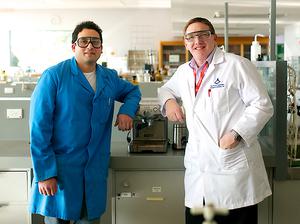Coffee
is a red berry before it's a bean.
This is bioprospecting at work. It may not smell as pleasant as the aroma of coffee beans, but Dr Smith is researching how to extract compounds from plant materials that can be used for medicinal purposes.
The results – using an unmodified household espresso machine – are exciting. Dr Smith extracted near-pure shikimic acid, an important precursor to the antiviral drug Tamiflu, from the spice star anise.
Natural product extraction

“I got a new coffee machine at home so I took my old one into the lab, thinking perhaps I could do natural product extraction from it – traditional methods are very slow and we know making coffee is quick,” he says.
We trialled it on lots of different things – plants, leaves, seeds. Seaweed didn’t work, it blocked the machine. For everything else, we were surprised at how clean the results were and, compared to other methods that took us days to do, we got an answer in three hours
The research has attracted international attention.
“Some of the nicest and most elegant solutions are right in front of you,” says fellow researcher Dr Alex Bissember. “We checked and double-checked whether this had been done before, because it’s so obvious – a simple solution to a complex problem.”
Efficiency and purity
At around $200, not only is a household coffee machine much more inexpensive than specialised extraction equipment that can cost tens of thousands of dollars – it brings speed, efficiency and purity. The pressurised hot water process isolates natural products while minimising extraction of plant pigments that can adversely impact purification.
Some of the nicest and most elegant solutions are right in front of you. We checked and double-checked whether this had been done before, because it’s so obvious - a simple solution to a complex problem
“It’s changed the way we teach,” Dr Smith says. “In research, purification is one of our biggest headaches. Anything that saves time on that is a benefit. Optimal extraction gives us more room to move in exploration.”
The team is now looking to identify pharmaceutical starting materials from other plants, including Tasmanian Pepperberry, which has antibacterial properties, and a common hedge that grows around the University’s Sandy Bay campus which shows a chemical structure similar to the anticoagulant drug Warfarin.
“Our entire pharmaceutical industry was founded on natural products or herbal remedies,” Dr Smith says. “Very few antibiotic drugs have come onto the market recently, for example, so the need to find new drugs is certainly still an important area.
“There are a lot of plants out there yet to be uncovered in this way.”
Interested in conducting your own research? Apply now to become a research student.